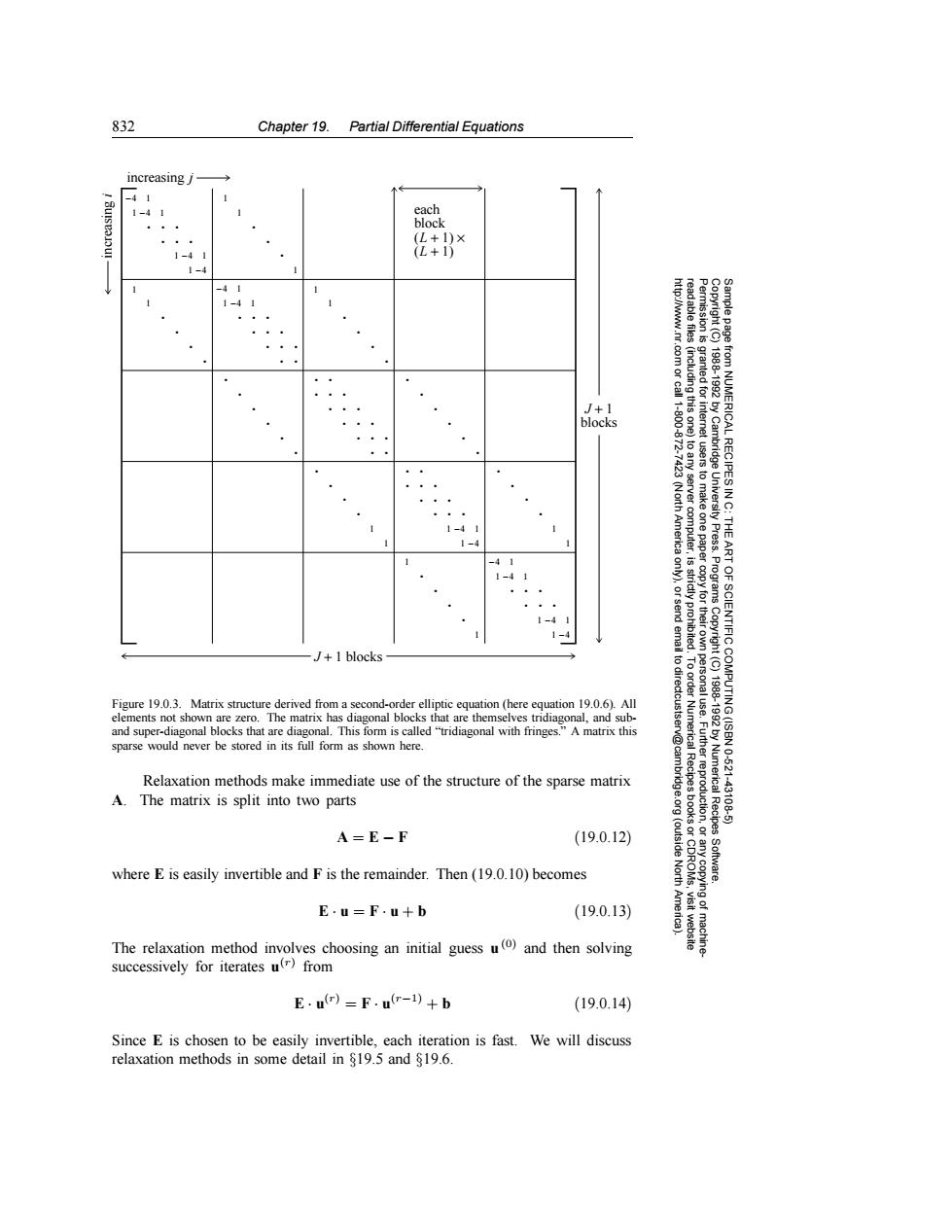正在加载图片...

832 Chapter 19.Partial Differential Equations increasing / 1 each block (L+1)× (L+1) -4 http://www.nr. .com or call J+1 blocks 11-800-872 (including this one) granted fori internet 1-4 -7423(North America 1-4 州pWer:s to tusers to make one paper 1988-1992 by Cambridge University Press. from NUMERICAL RECIPES IN C: THE -41 是 Programs e email strictly prohibited. J+1 blocks to dir Copyright (C) Figure 19.0.3.Matrix structure derived from a second-order elliptic equation (here equation 19.0.6).All elements not shown are zero.The matrix has diagonal blocks that are themselves tridiagonal,and sub- and super-diagonal blocks that are diagonal.This form is called"tridiagonal with fringes."A matrix this 18881920 ART OF SCIENTIFIC COMPUTING(ISBN sparse would never be stored in its full form as shown here. v@cam Relaxation methods make immediate use of the structure of the sparse matrix A.The matrix is split into two parts Numerical Recipes 10-621 43108 A=E-F 19.0.12) (outside where E is easily invertible and F is the remainder.Then (19.0.10)becomes North Software. E.u=F.u+b (19.0.13) visit website The relaxation method involves choosing an initial guess u()and then solving machine successively for iterates u(r)from E.)=F.nr-1)+b (19.0.14) Since E is chosen to be easily invertible,each iteration is fast.We will discuss relaxation methods in some detail in $19.5 and $19.6.832 Chapter 19. Partial Differential Equations Permission is granted for internet users to make one paper copy for their own personal use. Further reproduction, or any copyin Copyright (C) 1988-1992 by Cambridge University Press. Programs Copyright (C) 1988-1992 by Numerical Recipes Software. Sample page from NUMERICAL RECIPES IN C: THE ART OF SCIENTIFIC COMPUTING (ISBN 0-521-43108-5) g of machinereadable files (including this one) to any server computer, is strictly prohibited. To order Numerical Recipes books or CDROMs, visit website http://www.nr.com or call 1-800-872-7423 (North America only), or send email to directcustserv@cambridge.org (outside North America). −4 1 1 −4 • 1 • • • • 1 • −4 1 1 −4 J + 1 blocks increasing i increasing j J + 1 blocks 1 1 • • • • −4 1 1 −4 • 1 • • • • • • • • • • • • • • • • • • • • • • • • • • • • • • • • • • • • 1 • −4 1 1 −4 −4 1 1 −4 • 1 • • • • 1 • −4 1 1 −4 • • • • • • 1 • • • • 1 • • • • 1 1 1 1 • • • 1 • • • • • • 1 1 • • • • • • • • 1 1 each block (L + 1) × (L + 1) Figure 19.0.3. Matrix structure derived from a second-order elliptic equation (here equation 19.0.6). All elements not shown are zero. The matrix has diagonal blocks that are themselves tridiagonal, and suband super-diagonal blocks that are diagonal. This form is called “tridiagonal with fringes.” A matrix this sparse would never be stored in its full form as shown here. Relaxation methods make immediate use of the structure of the sparse matrix A. The matrix is split into two parts A = E − F (19.0.12) where E is easily invertible and F is the remainder. Then (19.0.10) becomes E · u = F · u + b (19.0.13) The relaxation method involves choosing an initial guess u(0) and then solving successively for iterates u(r) from E · u(r) = F · u(r−1) + b (19.0.14) Since E is chosen to be easily invertible, each iteration is fast. We will discuss relaxation methods in some detail in §19.5 and §19.6